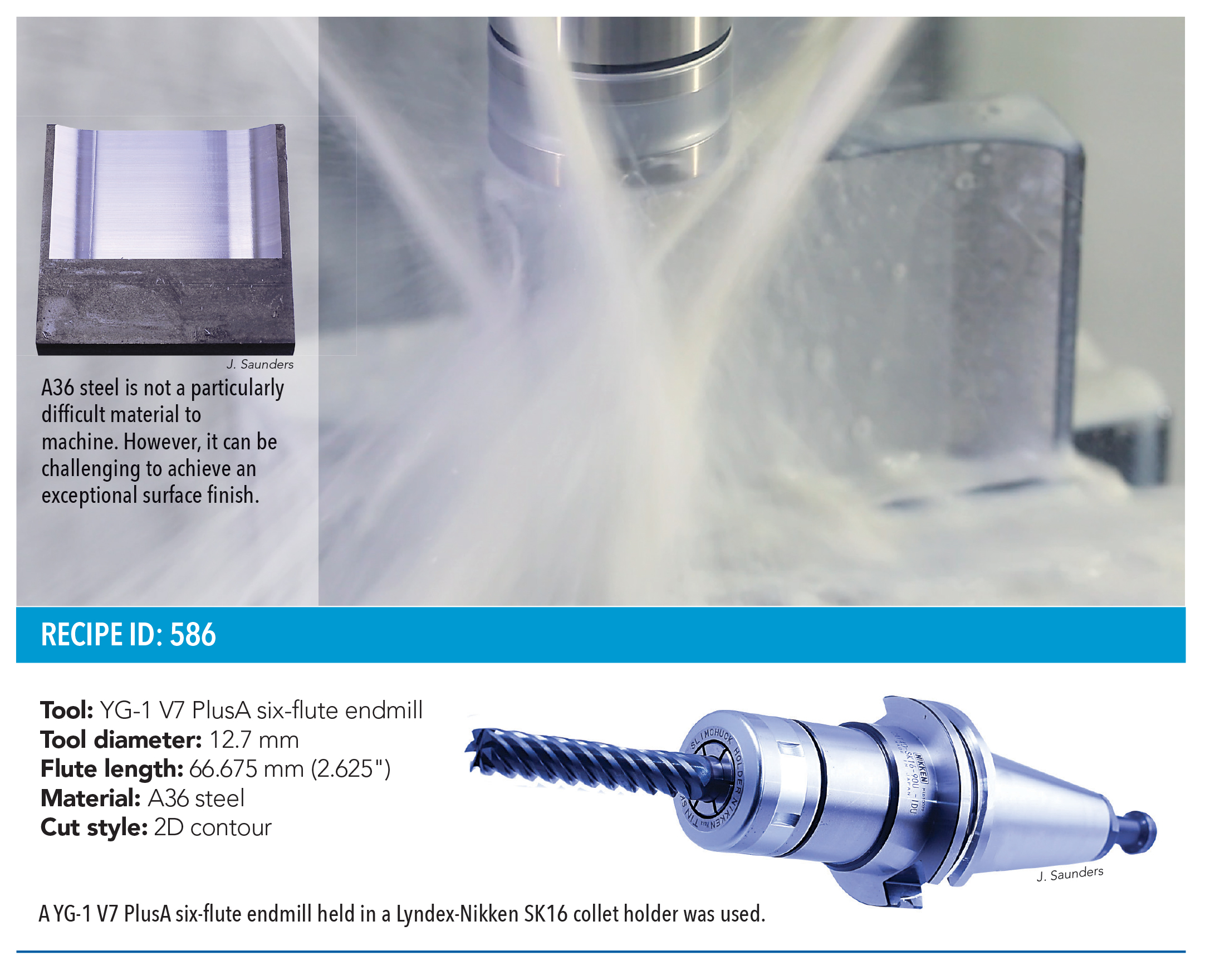Milling Speeds and Feeds for A36 Steel
Author John Saunders
Published
October 27,2020 - 10:45am
A 36 steel is not a particularly difficult material to machine. However, it can be challenging to achieve an exceptional surface finish, especially when a part calls for a 63.5 mm (2.5") axial depth of cut. The challenge for this ProvenCut recipe was to achieve an acceptable — or even excellent — finish with a tool length-to-diameter ratio of 5-1.
The larger a tool is, the stiffer it is. But large-diameter carbide cutting tools present problems. The cost goes up drastically. A 19.05 mm (0.75") tool may cost over twice the price of a 12.7 mm (0.5") tool — and rightfully so, as the former has 2.3 times the amount of carbide. For that reason, large-diameter endmills rarely are purchased or kept in inventory as frequently as smaller-diameter ones. Setting aside tool price, larger-diameter endmills also create more tool pressure, making them difficult to run on many common 40-taper machining centers.

A key to this recipe was finding a stiff 12.7 mm dia. endmill. That's right: The diameter of an endmill isn't the only factor in determining the stiffness of a cutting tool. The higher a flute count is, the thicker the core of a cutting tool is. However, higher flute counts must be balanced with increased tool pressure, which can lead to chatter due to more points of contact with raw material.
ProvenCut recipe 586 struck a wonderful balance, machining a piece free of chatter and yielding an extraordinary finish using a YG-1 V7 PlusA six-flute endmill held in a Lyndex-Nikken SK16 collet holder. The 2D contour finishing operation was programmed with Autodesk Fusion 360 and run at 210 m/min. (690 sfm) at 0.015 mm feed per tooth (0.0006" feed per tooth) with a 0.203 mm (0.008") radial DOC and 63.5 mm axial DOC.
To view a video of machining A36 steel at www.ctemag.com, enter this URL on your web browser: cteplus.delivr.com/2gpv6
Related Glossary Terms
- centers
centers
Cone-shaped pins that support a workpiece by one or two ends during machining. The centers fit into holes drilled in the workpiece ends. Centers that turn with the workpiece are called "live" centers; those that do not are called "dead" centers.
- chatter
chatter
Condition of vibration involving the machine, workpiece and cutting tool. Once this condition arises, it is often self-sustaining until the problem is corrected. Chatter can be identified when lines or grooves appear at regular intervals in the workpiece. These lines or grooves are caused by the teeth of the cutter as they vibrate in and out of the workpiece and their spacing depends on the frequency of vibration.
- collet
collet
Flexible-sided device that secures a tool or workpiece. Similar in function to a chuck, but can accommodate only a narrow size range. Typically provides greater gripping force and precision than a chuck. See chuck.
- depth of cut
depth of cut
Distance between the bottom of the cut and the uncut surface of the workpiece, measured in a direction at right angles to the machined surface of the workpiece.
- endmill
endmill
Milling cutter held by its shank that cuts on its periphery and, if so configured, on its free end. Takes a variety of shapes (single- and double-end, roughing, ballnose and cup-end) and sizes (stub, medium, long and extra-long). Also comes with differing numbers of flutes.
- feed
feed
Rate of change of position of the tool as a whole, relative to the workpiece while cutting.
- stiffness
stiffness
1. Ability of a material or part to resist elastic deflection. 2. The rate of stress with respect to strain; the greater the stress required to produce a given strain, the stiffer the material is said to be. See dynamic stiffness; static stiffness.
- web
web
On a rotating tool, the portion of the tool body that joins the lands. Web is thicker at the shank end, relative to the point end, providing maximum torsional strength.
Source: https://www.ctemag.com/news/articles/surface-finish-a36-steel
0 Response to "Milling Speeds and Feeds for A36 Steel"
ارسال یک نظر